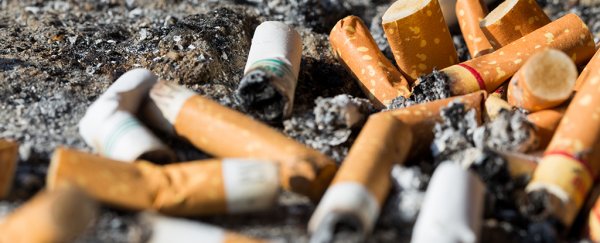Tiny cigarette butts add up to a huge amount of toxic waste – about 1.2 million tonnes a year – but scientists have come up with a new way of removing them from the environment: packing them inside roads and paths.
Asphalt made from cigarette butts was shown to not only seal up the dangerous chemicals they contain, but also to create an asphalt mix that traps less heat from the Sun, reducing the urban heat island effect that can increase temperatures in built-up areas.
According to the team from RMIT University in Australia, these butts are among the most common type of litter in the world, and they can take a long time to break down, all the while releasing damaging substances into the environment.
"I have been trying for many years to find sustainable and practical methods for solving the problem of cigarette butt pollution," says lead researcher Abbas Mohajerani.
Harmful chemicals including arsenic, chromium, nickel, and cadmium are trapped by the filters inside cigarettes and remain in the butts when they are discarded.
The team wrapped up the butts in normal asphalt used for road-making and paraffin wax used in electrical insulation, candles, and many other places. This locked in the leftover chemicals and prevented any leakage, then the encapsulated cigarette ends were mixed with more hot asphalt for testing.
As well as keeping the toxic chemicals sealed in, the resulting asphalt was shown to be capable of handling heavy traffic, while also reducing the thermal conductivity that leads to an urban heat island effect.
The researchers didn't say how quickly or easily the butt-based asphalt could be mixed for commercial use, but we could certainly benefit from it – some 6 trillion cigarettes are still produced every year.
And while the best solution would be to get people to give up smoking, the problem is unlikely to go away, with increases in world population estimated to increase that 6 trillion figure by 50 percent by 2025.
Mohajerani and his team are focussing particularly hard on the issue. Last year they produced fired-clay bricks with cigarette ends that worked like the asphalt, trapping the chemicals and putting the butt materials to good use.
That research revealed that bricks made from butts required less energy to make, were lighter, and had better insulation properties than standard bricks, meaning reduced household heating and cooling costs as an added bonus.
Also last year, a New Jersey-based company demonstrated how cigarette butts could be converted into plastic products, using a shredding and blending process to deal with materials that are notoriously hard to recycle.
If we can't get the world to give up smoking then we can at least start dealing with the waste in ways that are kinder to the environment.
"Cigarette filters are designed to trap hundreds of toxic chemicals and the only ways to control these chemicals are either by effective encapsulation for the production of new lightweight aggregates or by incorporation in fired clay bricks," says Mohajerani.
"This research shows that you can create a new construction material while ridding the environment of a huge waste problem."
The research has been published in Construction and Building Materials.
